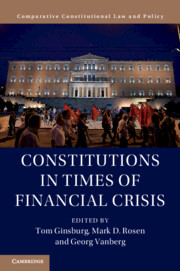Book contents
- Constitutions in Times of Financial Crisis
- Constitutions in Times of Financial Crisis
- Copyright page
- Contents
- Contributors
- Foreword
- I The Role of Constitutions in Dealing with Crises
- II Courts and Crises
- 6 The Place of Economic Crisis in American Constitutional Law
- 7 Financial Crises and Constitutional Compromise
- 8 Commitment for Cowards
- 9 Protecting Fundamental Rights During Financial Crisis
- III Supranational Governance and Crisis
- IV Implementing Austerity
- V The Effect of Crises on Constitutions
- Index
7 - Financial Crises and Constitutional Compromise
from II - Courts and Crises
Published online by Cambridge University Press: 08 June 2019
- Constitutions in Times of Financial Crisis
- Constitutions in Times of Financial Crisis
- Copyright page
- Contents
- Contributors
- Foreword
- I The Role of Constitutions in Dealing with Crises
- II Courts and Crises
- 6 The Place of Economic Crisis in American Constitutional Law
- 7 Financial Crises and Constitutional Compromise
- 8 Commitment for Cowards
- 9 Protecting Fundamental Rights During Financial Crisis
- III Supranational Governance and Crisis
- IV Implementing Austerity
- V The Effect of Crises on Constitutions
- Index
Summary
Crises pose challenges for the theory and practice of constitutionalism. A constitution designed for ordinary times may be inadequate to moments of crisis. For this reason, as John Ferejohn argues in his chapter in this volume, it may be prudent to provide mechanisms for the suspension of constitutional procedures in extraordinary circumstances. The Roman Republic had the dictatorship; many modern constitutions feature other “emergency powers.” But while there exist reasons to suspend some features of constitutions during crisis (most obviously, legislative procedures that may prove problematic when conditions require rapid decision-making), this is not true of all aspects of constitutions. The purpose of many constitutional provisions is precisely to constrain governmental action in extraordinary times. 1 Consider a common analogy for constitution-making: Ulysses, tying himself to the mast. 2 In calm seas, there is little need for this precaution; Ulysses chose to limit his ability to steer his ship in anticipation of the siren song.
- Type
- Chapter
- Information
- Constitutions in Times of Financial Crisis , pp. 117 - 145Publisher: Cambridge University PressPrint publication year: 2019
- 1
- Cited by



